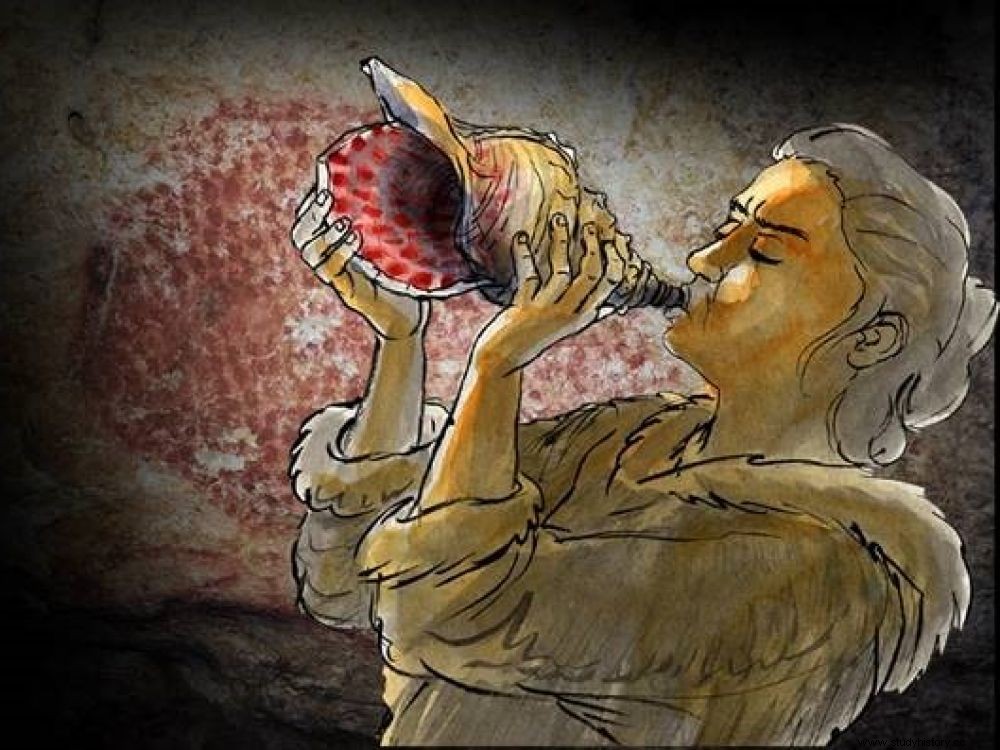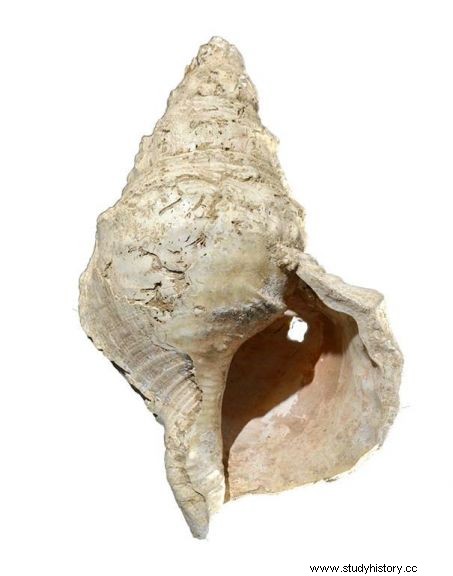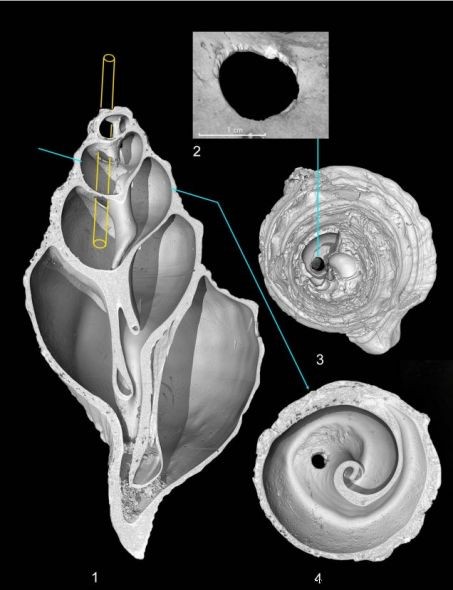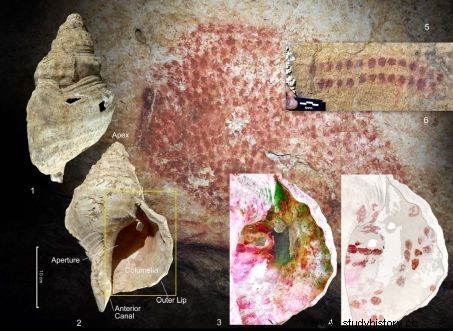The first sound recording from prehistory was obtained from a conch, a shell used by Magdalenian hunters in France 18,000 years ago. This exceptional discovery sheds light on certain practices of Upper Paleolithic societies with an unknown musical dimension.

Reconstruction of the use of the conch from the cave of Marsoulas. In the background, the bison punctuated with red ochre, adorning the walls of the cavity. Patterns identical to those decorating the interior of the wind instrument.
Powerful, long and deep… three notes from the mists of time have just been heard for the first time by a team of French scientists. Three notes, the lowest of which would be close to C and the other two respectively, C sharp and D (listen below) . It is by ringing an 18,000-year-old conch, a 30 cm shell of the genus Charonia lampas sp. (humpbacked newt) that scientists led by Carole Fritz and Gilles Tosello, associated with the Traces Laboratory -UMR 5608 of Toulouse-Le Mirail University, reached these results published on February 10, 2021 in the journal Science Advances . The shell was discovered in 1931 at the entrance to the decorated cave of Marsoulas, in the middle Pyrenees, on the edge of Haute-Garonne and Ariège. "We have identified the use of the oldest conch shell in the world in a prehistoric context" , rejoices the prehistorian Carole Fritz from Toulouse where Sciences et Avenir met her.
A thousand-year-old instrument forgotten for 80 years
To do this, Pascal Gaillard (CNRS), musicologist at the Laboratoire Cognition, Langues, Langage, Ergonomie (CLLE) in Toulouse and himself a former flutist, invited Jean-Michel Court, one of his horn player friends ], to blow into the conch. This immediately revived this thousand-year-old instrument forgotten for 80 years in the collections of the Toulouse Natural History Museum.

The conch of Marsoulas (Haute-Garonne) and its 31 cm in height. © Carole Fritz et al. 2021
Several other organizations have collaborated on this project, including the Laboratory of Molecular and Structural Archeology (LAMS) in Paris and the Musée du Quai-Branly-Jacques Chirac.
Powerful, long and deep… three notes from the mists of time have just been heard for the first time by a team of French scientists. Three notes, the lowest of which would be close to C and the other two respectively, C sharp and D (listen below) . It is by ringing an 18,000-year-old conch, a 30 cm shell of the genus Charonia lampas sp. (humpbacked newt) that scientists led by Carole Fritz and Gilles Tosello, associated with the Maison des sciences de l'homme et de la société (MSHS) in Toulouse, reached these results published on February 10, 2021 in the journal Science Advances . The shell was discovered in 1931 at the entrance to the decorated cave of Marsoulas, in the middle Pyrenees, on the edge of Haute-Garonne and Ariège. "We have identified the use of the oldest conch shell in the world in a prehistoric context" , rejoices the prehistorian Carole Fritz from Toulouse where Sciences et Avenir met her.
If you are unable to play the sound above, click on this link which takes you to the CNRS SoundCloud page.
A thousand-year-old instrument forgotten for 80 years
To do this, Pascal Gaillard (CNRS), musicologist at the Laboratoire Cognition, Langues, Langage, Ergonomie (CLLE) in Toulouse and himself a former flutist, invited Jean-Michel Court, one of his horn player friends ], to blow into the conch. This immediately revived this thousand-year-old instrument forgotten for 80 years in the collections of the Toulouse Natural History Museum.

The conch of Marsoulas (Haute-Garonne) and its 31 cm in height. © Carole Fritz et al. 2021
Several other organizations have collaborated on this project, including the Laboratory of Molecular and Structural Archeology (LAMS) in Paris and the Musée du Quai-Branly-Jacques Chirac. Thanks to everyone's work, this is the first time that a wind musical instrument has been clearly associated with a prehistoric archaeological site. "We can prove that sound was undoubtedly produced in Marsoulas Cave 18,000 years ago", assures Carole Fritz. Specialists were of course aware of the existence of some bone flutes dating from the Aurignacian (about 30,000 years ago) discovered in Germany, as well as the discussed use of possible rhombus [wind instrument producing sound by friction of ambient air ], or vague bone whistles. But never before has the proof that a conch had been used as a musical instrument in Europe been provided for the Magdalenian period. A shell whose distribution often thought to be limited to warm seas, "actually extends from Oceania, New Zealand, Europe, India, Tibet, Japan, Indochina, New Guinea, and beyond ", explain the authors of the article. In Marsoulas, for example, the conch is native to the coasts located 200 kilometers away. "It is of a mollusc that we still encounter in the Bay of Biscay and along the Basque and Asturian coasts of Spain ."

Remains of an arrangement of the concha to allow a cannula to pass. A mouthpiece . © Carole Fritz et al. 2021
Proof that this shell was intentionally reshaped to produce sound
"The Apex [the tip of the conch] has been removed from it, and the outer lip completely retouched to regularize the edge. The conch has undergone an arrangement for the installation of a mouthpiece" , explains Carole Fritz. This was confirmed by the CNES examinations."During a tomography, we discovered that the inside of the shell had been made. A hole had been dug there, probably to introduce a cannula, a tube used as a mouthpiece to better direct the air inside the shell to make it sound , continues Gilles Tosello. This is proof that this shell was intentionally reshaped to produce sound."

The Marsoulas conch (Charonia lampas sp.) and the red ocher thumb marks identified in its inner part. Footprints identical to those of the bison painted in the decorated cave presented in the background. © Carole Fritz et al. 2021
Even more than the instrument itself, it is the attested symbolic link between this shell and the rock paintings of the decorated cave of Marsoulas which surprised the scientists. Discovered in 1897, Marsoulas, called "the cave with 500 figures", has indeed about fifty meters of decorated wall. Among the animals that appear there, two imposing bison 2 meters long are painted and engraved, one of which is riddled with hundreds of dots made with the thumb, in red ocher (read Sciences et Avenir n°848 , 2017 ). Two extremely rare dresses in all Western parietal art. However, the analysis by tomography (CT) and X-ray fluorescence spectrometry of the conch showed that this shell housed in its internal part... identical traces. "The conch of Marsoulas indeed has tracings similar to those of the bison of the decorated cave ", specifies Carole Fritz. "The decorations of the conch therefore have an unmistakable symbolic meaning, even religious in connection with the cavity ", explains Gilles Tosello.
Did the hunters of the Magdalenian use the conch to hail from one valley to another in this mountainous region of the Pyrenees? Did they use it in ceremonies? Did they use it inside the cavity in connection with the parietal works? "We don't know. But for the first time we have a sound expression symbolically linked to parietal art. And that's unique in the world!" , smiles Carole Fritz.
